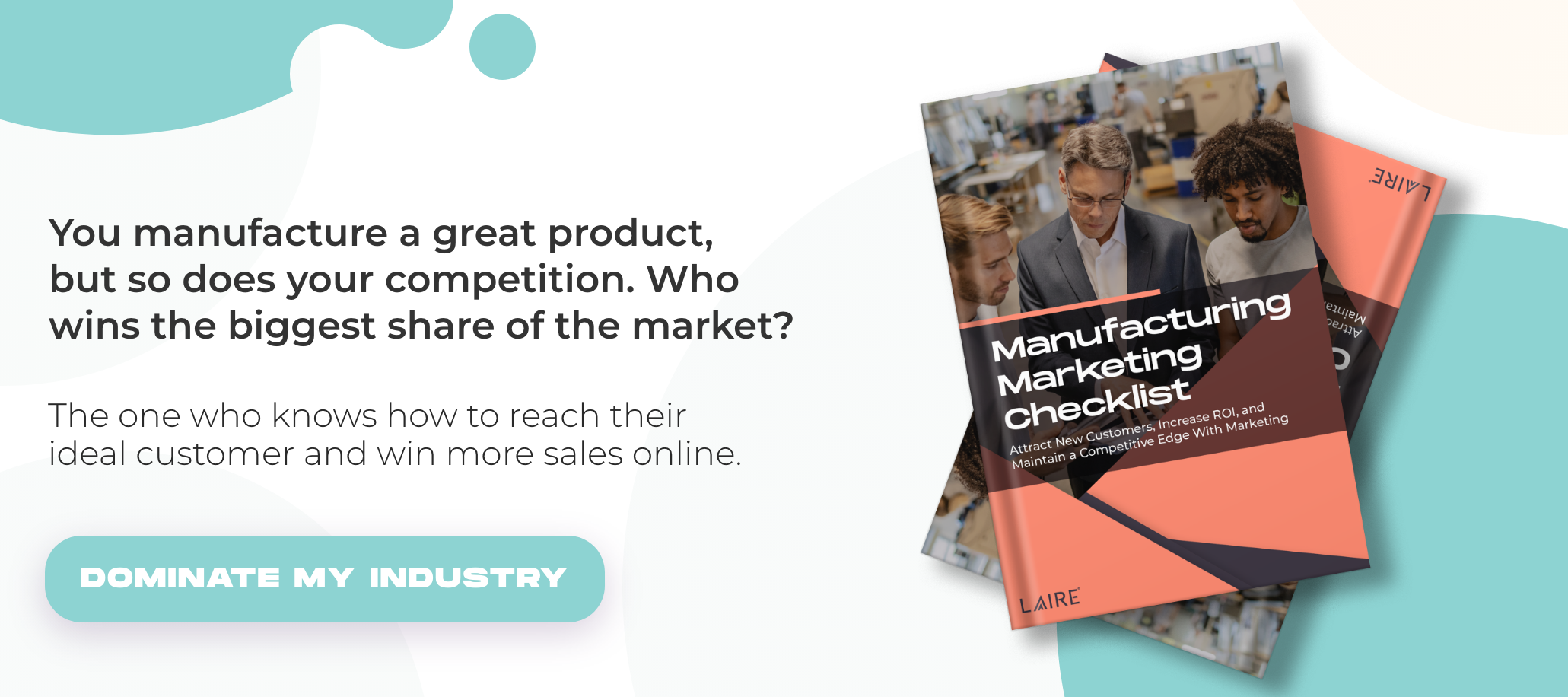Your sales team is the bridge between the products you manufacture and the consumers you serve, communicating a breadth of information to your customers from product specs to applications.
That’s why supporting your sales team with all the information they need in the most engaging, persuasive, and comprehensive manner — in other words, sales enablement — can be a make-or-break component of your sales process.
Sales enablement has one main focus: equipping your sales team with everything they need to sell successfully. Keep reading to uncover essential insights on sales enablement and explore how your manufacturing sales team can leverage valuable support through this practice.
What Is Manufacturing Sales Enablement?
Sales enablement for manufacturing companies is a practice that promotes sales growth through planning, content, and technology designed to empower sales teams. Effective sales enablement can help shorten sales cycles, improve buyer interactions, and increase sales team efficiency.
![[ROPS] The Ultimate Guide to Sales Enablement for Manufacturers_Graphic 1 Freepik](https://www.lairedigital.com/hs-fs/hubfs/Blog%20Images/%5BROPS%5D%20The%20Ultimate%20Guide%20to%20Sales%20Enablement%20for%20Manufacturers_Graphic%201%20Freepik.png?width=1250&height=556&name=%5BROPS%5D%20The%20Ultimate%20Guide%20to%20Sales%20Enablement%20for%20Manufacturers_Graphic%201%20Freepik.png)
The responsibilities of sales enablement can be broad and include activities such as:
- Sales training and coaching
- Creation of sales assets
- Sales and marketing communication
- Reporting and measurement of sales success
Sales enablement is not a substitute for marketing, and vice versa — while both areas focus on creating content, the primary audience of each team differs, as does the medium.
In an ideal business structure, marketing and sales enablement work hand-in-hand to create a consistent message for the consumer across all channels. This sales and marketing alignment can allow both teams to capitalize on their strengths and lean on each other to develop a strong message for the consumer.
3 Core Elements of Manufacturing Sales Enablement
![[ROPS] The Ultimate Guide to Sales Enablement for Manufacturers_Graphic 2 Freepik-1](https://www.lairedigital.com/hs-fs/hubfs/Blog%20Images/%5BROPS%5D%20The%20Ultimate%20Guide%20to%20Sales%20Enablement%20for%20Manufacturers_Graphic%202%20Freepik-1.png?width=900&height=400&name=%5BROPS%5D%20The%20Ultimate%20Guide%20to%20Sales%20Enablement%20for%20Manufacturers_Graphic%202%20Freepik-1.png)
1. Sales Enablement Planning
Planning is an essential first step in the process of building a solid sales enablement structure within your organization.
Any changing process requires a strong foundation that your sales reps can lean on when learning a new way of selling or revamping their existing strategies. Above all, your planning needs to outline your sales team’s areas of need, define your growth goals, and create a plan on how to achieve those goals.
Before you solve the “how” of implementing a sales enablement strategy, determine the “why” — why does my team need this?
2. Sales Enablement Content
The content you arm your sales team with should tell a story. As manufacturers, you know your customers are looking for precision, quality, and value when choosing a manufacturing partner, and this should be reflected in every piece of content you create.
Here are just a few examples of the types of content an expansive sales enablement program would produce for their sales team:
- Case studies/customer testimonials
- Competitive research/battle cards
- eBooks/whitepapers
- Blog posts
- Executive presentations
- Sales scripts
Throughout your content library, you should always aim to answer a few key questions that your buyers may have. What is the value of this product or service? Will I see the ROI I want? Why is this product or service the best option for me?
Anticipating what your buyers are going to ask can help you create content tailored to the customer, not to your offering, and you can add on to your content as your sales team gets more experience with a new framework.
3. Sales Enablement Technology
Investing in the technology your sales team needs will support a more efficient and effective sales process, but how do you know the tools that are right for your salespeople?
There are many sales enablement tools out there, and each offers a different benefit to help your sales team further develop their skills. Discover a few of the types of sales enablement technologies you may consider implementing:
- CRM Integration can help reduce manual data entry and more efficiently connect potential leads to manufacturing sales reps. Platforms like HubSpot, Marketo, and Salesforce can help facilitate these processes.
- Sales Content Management platforms such as Highspot and Seismic offer a centralized platform for salespeople to access all the content they need, both in the office and on the go.
- Video Coaching and Practice from platforms like Mindtickle and Brainshark can offer even the most experienced salespeople the benefit of additional practice from an outside perspective.
- Sales Intelligence platforms like LinkedIn Sales Navigator allow your salespeople to collect insights from their interactions and apply the data toward making improvements in their processes.
Sales Enablement Tips for Manufacturers
Elevate your manufacturing sales strategy with these effective sales enablement tips tailored to enhance your team's performance and drive success in a competitive market.
Define Your Target Audience
To deliver the most effective sales message for your customer’s specific needs, it’s essential to narrow your scope and define a target audience. Crafting buyer personas is a strategic approach to uncovering the demographics, purchasing behaviors, and professional requirements of your ideal customers.
Recognizing that personas differ across various organizational levels and company sizes, creating multiple versions enables you to effectively target a diverse range of individuals — from executives to operators, programmers, and beyond.
You’ll then be able to guide them through a planned buyer journey, which outlines the customer’s path from introduction to purchase.
Plan Your Content
Whether you’re selling a new product or expanding your customer base of an existing offering, you may have a bank of content that your sales team relies on with a wide range of topics, formats, and messaging.
Creating a content strategy that works means that these areas should be in alignment; every piece of content should support the sales process and be able to send a clear message on its own or paired with supporting content pieces.
Perform an audit of existing content — determine what works, what doesn’t, and what can be edited or adapted to fit your goals. Once you’ve established any gaps, a content calendar can be a helpful tool for planning and scheduling future content that will round out your library.
Enable Sales Access to Content
Once you’ve created a library of content for your sales team to utilize, where does it live?
Whether you have a centralized folder in your office server or on a content management platform, it’s important to make your sales enablement content easily accessible to your sales team so there’s minimal hassle in accessing the valuable information they use on a day-to-day basis.
Your content may need to be updated and edited over time. When this occurs, be sure to communicate with your team about any updates that have been made to ensure they’re not referencing an outdated piece of content.
Keep It Buyer-Focused
According to Salesforce, 88% of customers say that the experience a company provides is as important as its products and services.
Throughout your sales enablement development, from creating your buyer personas to investing in helpful tools and technologies, you are setting your sales team up to foster a better buyer experience, from their first impression to a closed sale.
Building meaningful relationships with your customers will not only result in increased satisfaction with their buying experience but can lead to even further sales opportunities in the future. Creating customers is one thing, but creating loyal customers will take your sales to the next level.
![[ROPS] The Ultimate Guide to Sales Enablement for Manufacturers_Graphic 3 Freepik](https://www.lairedigital.com/hs-fs/hubfs/Blog%20Images/%5BROPS%5D%20The%20Ultimate%20Guide%20to%20Sales%20Enablement%20for%20Manufacturers_Graphic%203%20Freepik.png?width=1250&height=556&name=%5BROPS%5D%20The%20Ultimate%20Guide%20to%20Sales%20Enablement%20for%20Manufacturers_Graphic%203%20Freepik.png)
Master Manufacturing Sales Through Sales Enablement
For manufacturers, sales enablement proves to be a powerful tool, facilitating the development of an efficient sales process and driving growth in manufacturing sales.
Equipping your manufacturing sales representatives with essential content, training, and coaching empowers them to convey a clear and impactful message to potential buyers. Tailoring tools and content to align with your business's unique needs ensures they serve as a dynamic and comprehensive resource, evolving alongside your sales team.
To learn more about digital marketing for manufacturers, download our free guide:


